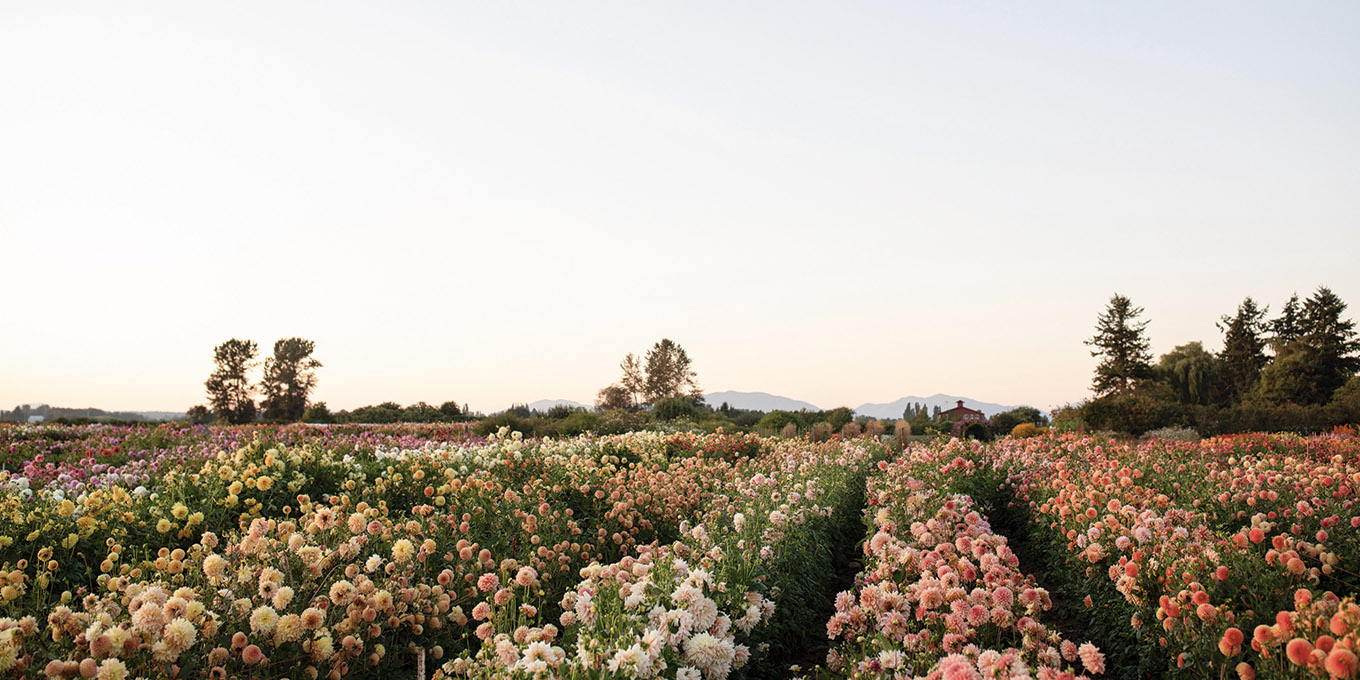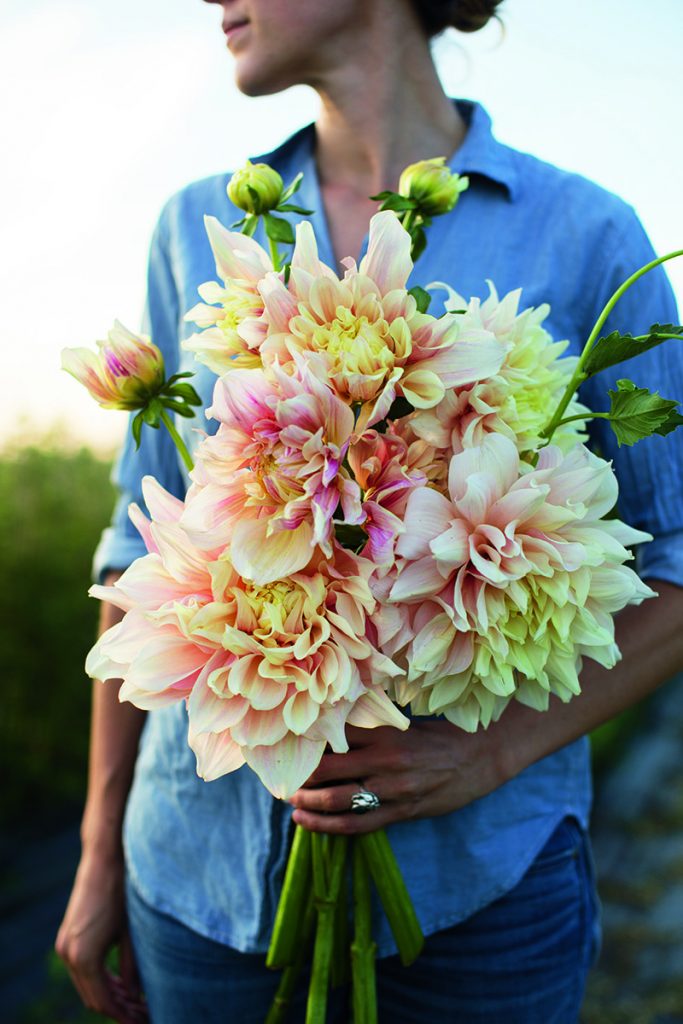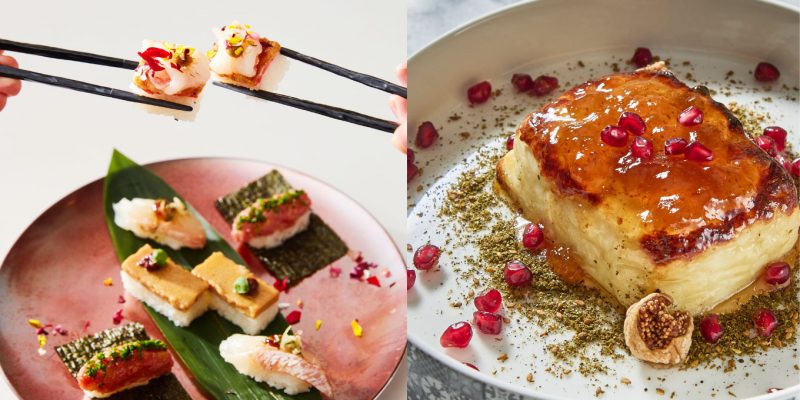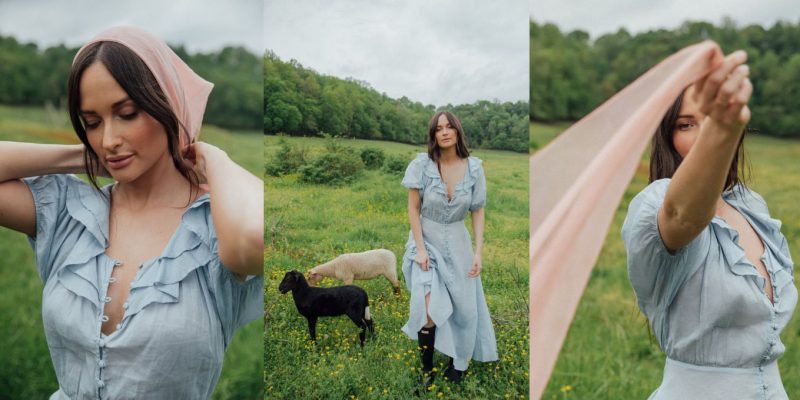Society
What You Should Know Before Moving From City to Farm
The dream of fleeing the city and living off the land has never been more popular—but what does it really take to get off the grid and grow something?
by : Eve Thomas- Oct 19th, 2021

Chris Benzakein
It all began on Instagram. While working in fashion in Montreal, Jen Salvador became invested in the world of Floret, a family-run flower farm in Washington state that has almost a million followers on the app. She was so captivated by the pastel fantasy it presented that she used her three weeks’ vacation to take a floral-design course in Toronto, mostly dealing with baby’s breath, carnations…the stuff you see in plastic wrap at the grocery store.
But she wanted more. She wanted the dizzying rows of daffodils and the wheel-barrows full of peonies she saw on her feed in between other accounts’ sun-dappled shots of powder-blue eggs and fluffy Highland cattle. She also wanted to know where the flowers came from and how they were grown. “We don’t really consider pesticides [when it comes to] flowers the way we do with food,” she says. “But you press your nose into them; you put them on the dinner table.”
So, Salvador decided she would grow them herself. Using some savings and the income from a few freelance design contracts, she and her partner bought his grandparents’ 53-hectare Nova Scotia farm—a plot of land that hadn’t been worked in 40 years and started her company, Flower Supernova. “Last year, our main harvest was rocks,” she jokes, grimly recalling the havoc wreaked by grasshoppers, deer and drought. This year, however, she has 300 dahlias growing on 2,000 square metres and plans to harvest and cellar the tubers over the winter to market them to home gardeners in the spring. “I want to eventually share my own journey and inspire people the way I was inspired.”
Perhaps you’ve felt the same pull while scrolling through rural-real-estate listings or buying seeds for your balcony garden—that lingering feeling that all of your problems would slip away if you could just live off the land somewhere. While the urge to escape to the country is nothing new (see: gentleman farmers, #cottagecore, Marie Antoinette’s Hameau de la Reine), it does seem to have grown stronger for many people in recent years amid fears of food insecurity and climate change, not to mention the rising cost of city living, the pandemic and the increasing ability to work from home. And while for some this dream never goes beyond an aesthetic obsession with gingham picnic blankets and herb-studded focaccia, for others it is less about the looks and more about the labour and logging off to go touch grass.
And while an environment-minded city-raised millennial Filipina-Canadian with no agricultural background may not fit the old stereotype of a Canadian farmer, in a country where the average age in the industry is 55 (and the shrinking farming population reached a historic low in 2011), newcomers like Salvador are sorely needed.
“Farming is still controlled by old white men, but a lot of their kids don’t want to take over once they retire,” says Ananda Fitzsimmons, president of the board of directors at Régénération Canada, a non-profit devoted to regenerative soil practices (think compost and cover crops over fertilizer and pesticides) that has members across Canada producing everything from bison meat to Pinot Gris. “A huge amount of land is going to change hands in the next decade, and anyone who is just getting into it now is going to be politically active on some level.”
Fitzsimmons herself fled the city in the ’80s as part of the “back to the land” movement, when she and five families tried to make communal living work on a farm in Quebec. “We had absolutely no idea what we were doing,” she says with a laugh, noting that the locals weren’t terribly impressed with their new hippie neighbours. She tried again, this time on a farm closer to Montreal surrounded by artists and “eco-people”; she has been living there full-time since 1992, growing and preserving enough food to be self-sufficient.
 Pexels
PexelsAnd the neighbours? They’re working overtime to attract fresh blood so they can keep their local post offices and schools. Also helping to lure aspiring agriculturists are resources like Arterre and Young Agrarians—organizations that facilitate mentorships, internships and land-matching between new- comers and experienced farmers and landowners.
About 100 kilometres away from Fitzsimmons, in Quebec’s Chateauguay Valley, Stephanie McBride confesses that she, too, was incredibly naive when she first established her farm, Old Wood Hollow. “I thought all chickens could lay eggs, even roosters,” she says. Four years later, with help from an agricultural-start-up grant, the 35-year-old mother of three grows no-till vegetables and raises heritage Mangalitsas (the “Kobe beef” of pigs), sending out weekly community-supported agriculture boxes and supplying top Montreal restaurants like Elena, Lawrence and Park. Her husband works on the West Coast most of the month, so it is often a one-woman operation, along with a staff that’s been made smaller during the pandemic.
Although McBride—with her smooth skin, wavy brown hair and crisp overalls (“I swear I don’t wear these all the time; it’s a coincidence!”)—could easily pass for an influencer, she only created her website at a friend’s insistence, and when she does post, the sunsets and pony rides are balanced out by unflinching honesty. “Nature doesn’t care if you had a bad day,” she says. “Sometimes I’m so tired that I cry the whole time I’m working.”
Just a sample of her morning routine is enough to snap any city mouse back to reality: up at 4 a.m. to do paperwork, quality control on last night’s harvest and health checks on 26 pigs and piglets, make breakfast for her kids and dogs and attempt to move an enormous shelter for the free-range animals.
McBride takes setbacks in her stride and knows first-hand the steep cost of failure. She tears up while describing an early frost that destroyed all her eggplant seedlings and again over a sow she lost to an unplanned birth. Every delay or mistake can mean the loss of an entire crop, a high-profile customer or precious time with her family. At the same time, she says, her perspective on more conventional tragedies has changed. While she and the kids used to hold funerals for each deceased chicken, now the dead animals go right into the compost, where they can return to the soil.
McBride is Indigenous but was raised by adoptive Scottish parents, and she credits both aspects of her background for her shifting perspectives on land stewardship and the cycle of life. “When my father used to take me out deer hunting, he explained that they were overpopulated and would starve otherwise,” she says. “He was really clear that when you take a life, you have to be accountable.”
“I want to eventually share my own journey and inspire people the way i was inspired.”
McBride is sharing her nascent wisdom with friends and family a lot these days as they move out to the country and visit the farm more. She hopes to support the growing community with new (admittedly Instagram-friendly) projects, including converting an old building into a cider brewery and stocking her recently purchased general store with local products like charcuterie and wine.
Over in Nova Scotia, Salvador’s community remains largely virtual for now. She takes Floret’s online courses at her own pace and hopes to eventually grow a thousand dahlias, breeding and naming her own varieties. She still takes design contracts to support herself and her partner; an outside job is a reality for most modern farmers. “My friends sometimes envy the life they think I have,” she says. “But we all have problems—they’re just different kinds. I’m far from my family, and it’s harder to earn a paycheque. But I feel less stress, and I’ve got a new-found appreciation for everything that grows.”
 Chris Benzakein
Chris BenzakeinFour decades ahead of Salvador on her journey, Fitzsimmons agrees. “I have so much space around me now, and I love being in touch with the seasons,” she says. “The wonder of it never gets old.” McBride expresses a similar sentiment on her blog: “The little things I worried about before starting Old Wood Hollow… I can’t even remember them now because they can’t compare, for me, to the rhythm of life here.”
It’s enough to keep you dreaming.
Read more:
Billie Eilish Is Calling the Shots
10 Things We’re Loving in October
Jonathan Van Ness: The Art of Authenticity
Newsletter
Join our mailing list for the latest and biggest in fashion trends, beauty, culture and celebrity.
Read Next

Fashion
Are Fashion Brands Getting Greener?
While the fashion industry is making a lot of noise about being more sustainable, a closer look shows that its earth-friendly commitments are often more illusion than reality.
by : Marouchka Franjulien- Apr 19th, 2024

Beauty
What Beauty Packaging Is Actually Sustainable?
We sought out leaders in the field to help us get to the bottom of the blue bin once and for all.
by : Victoria Christie- Apr 19th, 2024

Beauty
Tested and Approved: Your New Hydrating Skincare BFF
This new product has all of your skin’s thirst-quenching needs covered.
by : ELLE Canada- Apr 17th, 2024




